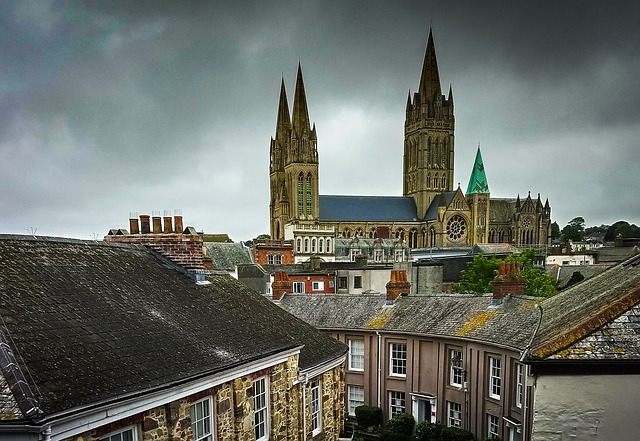By Tim Lambert
Truro in the Middle Ages
Truro began as a Celtic village. The Normans built a castle by the settlement. The castle stimulated the growth of Truro. The castle’s garrison provided a market for goods made in the settlement and it grew into a town. At some point (the exact date is not known) a market began in Truro. In the mid 12th century the Lord of the Manor granted Truro a charter (a document granting the townspeople certain rights).
However, Medieval Truro was a very small town, even by the standards of the time. It only had a population of several hundred.
Nevertheless, Truro was a busy town. It was, of course, in the centre of a tin mining area. From the 14th century, Truro was a stannary town. Before it was bought and sold copper and tin had to be assayed (tested then given a stamp to verify its quality). This was done in towns called Stannary towns (from the Latin word for tin, stannum). After being assayed metal was transported along the river to the sea.
However, the main industry in Truro itself was making wool. After it was woven the wool was fulled. That means it was pounded in a mixture of water and clay to clean and thicken it. The wool was pounded by wooden hammers worked by watermills. After it dried the wool was dyed.
In the 13th century, Dominican friars arrived in Truro. The friars were like monks but instead of withdrawing from the world, they went out to preach and help the poor. Dominican friars were called blackfriars because of the color of their costumes.
From 1295 Truro sent 2 MPs to parliament.
Truro 1500-1800
Truro gained a grammar school in 1549, a sign of its prosperity.
Through the centuries Truro was a little port and market town. In the late 18th century and early 19th century, it began to grow rapidly. New streets were built. Bridge Street is named after a new bridge, erected in 1775. Lemon Street is named after a merchant, William Lemon, who built houses in the street at the start of the 19th century. Also in the early 19th century Edward Street, Castle Street, and Francis Street were built.
In 1787 Assembly Rooms were built for card games and balls. A theater was also built. Truro was also a popular shopping centre for the local gentry.
In 1790 an Act of Parliament formed a body of men called Improvement Commissioners with powers to clean and light the streets of Truro.
Modern Truro
By 1801 the population of Truro was about 7,000. By the standards of the time, it was a fair-sized town. By 1851 it was nearly 11,000. However, the population of Truro stagnated in the second half of the 19th century.
There were a number of improvements in Truro in the 19th century. Truro gained gas light in 1822. The Municipal Buildings were erected in 1867. Truro gained a volunteer fire brigade in 1868. In the late 19th century Truro gained a piped water supply.
However, like all Victorian towns, Truro was overcrowded and unsanitary. There were outbreaks of cholera in 1849 and 1853.
In 1838 Truro ceased to be a Stannary town but the port continued to flourish. Truro is the only city in Cornwall. It became a city in 1877 when it was given its own bishop and separated from the diocese of Exeter. The foundation stone of Truro Cathedral was laid in 1880 by Prince Edward (later Edward VII). The cathedral was designed by John Loughborough Pearson (1817-1897).
By 1901 Truro had a population a little over 11,500. The population grew slowly in the first part of the 19th century. By 1951 it was still less than 13,000.
Truro War Memorial was unveiled in 1922. Truro gained an electricity supply in 1927 and the Catholic Church of Our Lady of the Portal and St Piran was built in 1972.

Today the population of Truro is 19,000. The port of Truro is still flourishing and there is some light industry in the town.